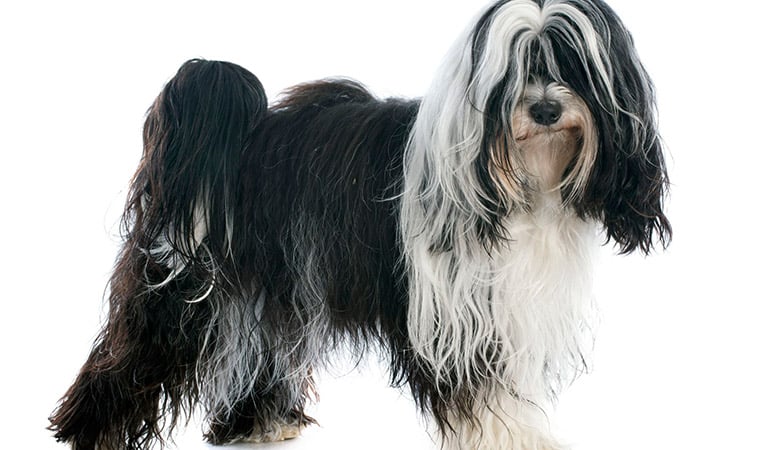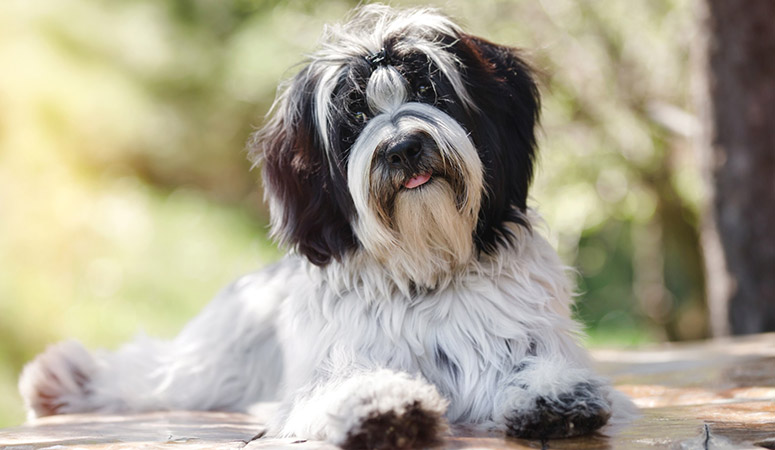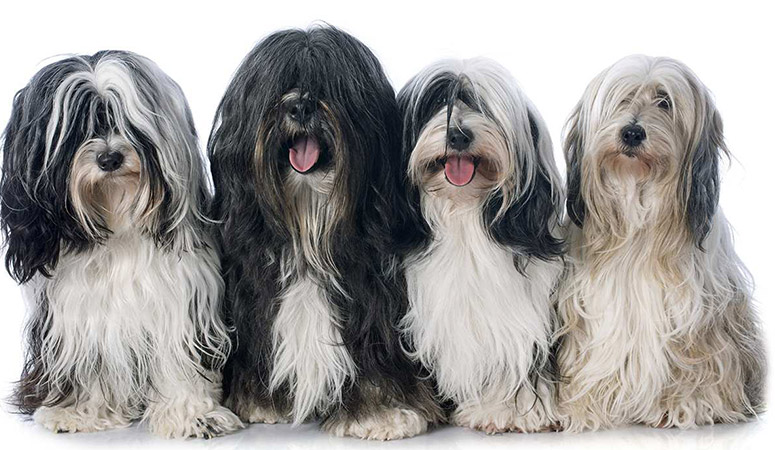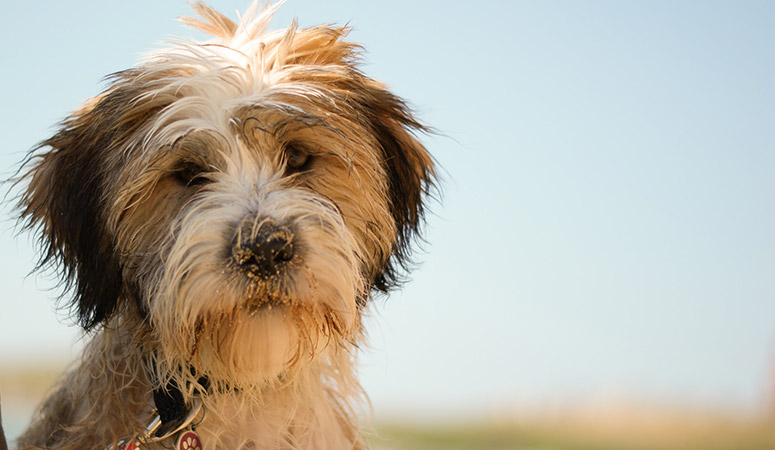Tibetan Terrier

The Tibetan Terrier is an ancient watchdog with shaggy coat and medium size, known as “Holy Dog of Tibet”. They are not really a terrier. Intelligent, sensitive and alert, they were watchdogs, but today the dogs have been developed into the Tibetan Terrier no longer herd, instead serving as companion dogs. This breed is affectionate and loving pets who are devoted to their families.
| Other Names | Dhoki Apso, Tsang Apso |
| Color | Black, Black & White, Black White & Gold, Brindle, Gold, Gold & White, Golden Brindle, Sable, White, White & Black, White & Gold |
| Height | Males: 14-17 inches. Females: 12-15 inches. |
| Weight | Males: 18-30 pounds. Females: 18-30 pounds. |
| Life Span | 15-16 years |
| Personality | Affectionate, Loyal, Sensitive |
| Exercise | Needs Lots of Activities |
| Origin |
| Popularity | #101 |
| Groom Needs | 2-3 Times a Week Brushing |
| Kids Friendly | Yes |
| Dog Friendly | Yes with supervision |
| Watch Dog | |
| Family Dog | Yes |
| Litter Size | 5 to 8 puppies |
Tibetan Terrier Pictures
Tibetan Terrier Video
Introduction
A miniaturized Bearded Collie is what it may look like in its shaggy coat, with full fur and a medium-sized body. But unlike many other dog breeds, the Tibetan Terrier appears to be unique with their broad, flat feet which harbor some hair between the toes. The hair becomes helpful when they climb mountains or pad on snow. Tibetan Terriers have square features and a moderate head. They come in almost any color, although the chocolate and liver coat colors are not acceptable.
According to legend, the loyal, lovable and affectionate Tibetan Terrier, now domesticated by many, was once revered in Tibet, which earned them the nickname “Holy Dogs of Tibet”. As medium-sized dogs, they weigh around 19-35 pounds at the scale, standing 13-17 inches from shoulder to paw. The females run quite smaller than the males. Tibetan Terriers have an average lifespan of 14-16 years.
Living with Tibetan Terrier
With long coat, the Tibetan Terrier requires daily brushing during adolescence when the coat changes to keep it free of tangles. Be sure to brush all the way down to the skin. And begin accustoming your Tibetan Terrier to being brushed and examined when he’s a puppy.
By approximately 18 months of age, you can get by with grooming one with a pin brush, a spray bottle, a metal “greyhound” comb and ear powder to three times a week to mist the coat.
Bathe your Tibetan Terrier at least monthly. He may need a bath more often if he plays outside frequently and gets dirty.
Trim their nails once or twice a month to prevent cracking. Short nails keep the feet in good condition, don’t get caught in the carpet and tear, and don’t scratch your legs when your Tibetan Terrier enthusiastically jumps up to greet you.
Wash your TT’s ears weekly with a gentle, dog-friendly cleanser to prevent dirt buildup that can cause infections.
Using ear powder to make the hair less slippery, pluck excess hair in the ears, and trim the hair between the footpads.
Brush your Tibetan Terrier’s teeth at least two or three times a week to remove tartar build-up and the accompanying bacteria. Brushing every day will be better for his oral health.
Make grooming a positive experience filled with praise and rewards, and you’ll lay the groundwork for easy veterinary exams and other handling when he’s an adult.
A healthy TT requires an hour or so of vigorous physical activity each day to remain fit. A few 20 minute walks, and some exuberant play sessions will suffice.
Many TTs enjoy a post in the house where they can look out a window or door and perform sentry duty for their household. If this spot is an overlook like a stair landing or balcony, all the better.
Naturally, puppy and adolescent Tibetan Terriers are filled with energy and excitement and require higher levels of stimulation and exercise. One walk a day isn’t sufficient for this breed – it needs to get out at least twice a day.
It really comes in handy if you have a large, secure yard your dog can run around in. While walking your Tibetan Terrier, make sure it is always on a leash.
One important thing to remember is that your Tibetan Terrier needs to release its pent up energy, otherwise it may become destructive. A really bored Tibetan Terrier is an escape artist who’s perfectly capable of climbing, jumping, or digging his way over or under a fence.
Thanks to this dog’s mischievous streak, it may try to escape and explore the great outdoors. And if you chase after it, it’s all a big game to this pooch.
Tibetan Terriers enjoy getting outside for adventures with family members. Their weatherproof coat keeps them comfortable outside even in the cold, rain, and snow.
The Tibetan Terrier requires a high-quality diet to provide the nutrition it needs, whether it’s commercial dog food or a homemade diet. But the amount of the food should vary with the dog’s age, size, activity level and metabolism.
The quality of dog food you buy also makes a difference — the better the dog food, the further it will go toward nourishing your dog. The first ingredient should always be protein, not byproducts. As well, it should include vitamins and minerals, carbohydrates, and fatty acids, which are usually met by high-quality dry food for dogs and they can offer complete nutrition in a convenient form.
A traditional Tibetan diet would include staples such as easily digestible gruel (cooked barley flour), and meat broth. Historically, the diet of peasants promoted longevity, while the rich foods of kings created disease.
With this in mind, it is best to feed an honest food with real ingredients, and trust a TT to eat what he needs rather than rely on the instructions on a feed bag. A lean dog is more energetic, healthier, and full of happy life force!
With an average life span of 12 to 15 years, generally Tibetan Terrier are healthy, but sometimes they may suffer from different health conditions, such as hip dysplasia, hypothyroidism, patellar luxation, progressive retinal atrophy, lens luxation, cataracts, diabetes mellitus, glaucoma, etc.
Early spay and neuters can predispose dogs to joint issues. Many breeders request that the dog reach maturity before altering.
Occasionally senior TTs are struck with vestibular disease, which is fortunately something from which they can recover. Cancer is an increasing concern in aging TTs.
A responsible owner will screen breeding stock for these health conditions regulary. Genetic tests (such as for NCL, LL, PRA, etc.) are a valuable tool used by breeders to eliminate the expression of those diseases in their puppies.
Other health tests include hip evaluation, PLL DNA test, NCL DNA test and ophthalmologist evaluation, which also can help the breeder to diagnose some diseases early and make some prevention measures.
Total Annual Cost: $2889
Cost is estimated for the first year and may vary depending on many factors, such as dog food, health care, leash, collar, licensing, possible fencing, crates, training and obedience classes, dog-walking, grooming, treats, toys, flea, tick, and heart-worm meds, microchips, etc.
With independent-minded, Tibetan Terrier is quick to learn and will wither under obsessive repetition or harsh methods.
TTs are enthusiastic students who love working closely with their owner in things such as agility, rally, and nose work. Also they like performing jobs that contribute to the household.
Training practices will allow the dog to choose the right behavior. TTs are generally amiable, but sometimes they have their own agenda. So keep training fun and consistent.
They are sensitive to harsh treatment, while positive reinforcement and dog treats work best with this breed.
Housetraining can take time, but you’ll be successful if you’re patient and give your Tibetan Terrier a regular schedule and plenty of opportunities to potty outdoors, praising him when he does so.
Crate training is strongly recommended, which will make housetraining easier and keep your Tibetan Terrier from chewing things while you are away. But don’t keep your dog locked up in the crate for long periods. The best place for a Tibetan Terrier is with you.
Hunting is not their strength. They have great capacity for love and devotion to their people. Clicker-training instruction is widely available, and both human and dog will enjoy the developing partnership from training together, where they seek companionship based on mutual cooperation, trust and respect.
History
The Tibetan Terrier, as the name suggests, had originated from Tibet, although contrary to the name, it is not a terrier. It was erroneously given the English part of its name by European travelers who recognized a resemblance between the dog breed and several other terrier breeds of England. Tsang Apso is more popularly used to refer to the breed in their homeland, Tibet. With Apso, meaning shaggy or bearded dog, it was associated with the province of Tsang. Tibetan myths affirm that the breed had existed even before the Common Era, and the gene pool was never adulterated.
The Tibetan Terriers used to be utilitarian dogs, rendering services as watchdogs, herd dogs, companion dogs, and so on. They were even held in high estimation for the belief that they carried good luck charm, and as such, they were sacred and never sold. Tibetan Terriers were rather given as gifts by Buddhist monks to support a good cause. The first Tibetan Terrier in Europe was recorded in 1922 when Dr. A. R. H Greig, an English Physician, returned with a dog after performing a surgical operation in Tibet. It was a female puppy of the breed of Tibetan Terriers, although when in 1924, the first litter was produced they were registered as Lhasa Terriers. The breed was officially named Tibetan Terrier in 1930 by the Kennel Club of India.
In the United States, the Tibetan Terrier breed wasn’t known until the mid-1950s when a doctor imported them. The breed gradually developed and was later recognized by the American Kennel Club in 1973.
Helpful Information
Breed Club: TIBETAN TERRIER CLUB OF AMERICA, INC.
Breed Club Link: https://ttca-online.org/
Breed Club Rescue: TIBETAN TERRIER CLUB OF AMERICA
Breed Club Rescue Link: https://ttca-online.org/tts-in-rescue/




